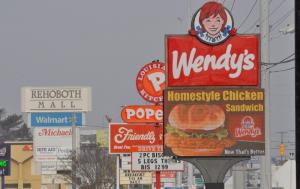Sussex focuses on billboards as moratorium deadline looms
With a month remaining on a year-long billboard application moratorium, Sussex County Council is being forced quickly to make a decision to end the moratorium or extend it.
The decision coincides with other possible action on county sign regulations as officials mull over possible recommendations from a working group of stakeholders, lawyers, staff and county officials.
Members of county council, planning and zoning commission and the board of adjustment met Feb. 9 in a workshop to hear the group's recommendations. “It's been a productive group with a lot of good feedback,” said James Sharp, assistant county attorney. “Some parts we agreed to disagree on, but we were able to come up with several recommendations.”
“We can't make any decisions today but we need to discuss where we go from here,” said County Administrator Todd Lawson. “If we agree there are some possible new regulations, we will need to amend the ordinance.”
At the end of the workshop, officials agreed to put the matter on upcoming agendas of council, the planning and zoning commission and board of adjustment for further discussion. “We need to boil all of this down,” said Vince Robertson, assistant county attorney.
A final presentation of recommendations will be made during a future county council meeting. If changes are proposed to the sign ordinance, public hearings before council, and planning and zoning commission will be required.
Lawson said there is not enough time for council to act on any possible changes before the March 15 billboard moratorium deadline. Council will have to take action on that issue during a meeting before the deadline.
“You can't leave that moratorium hanging out there,” Robertson said. “You have to at least act on billboards.”
The group provided written comments and possible recommendations regarding billboards or off-premises signs, so-called bandit signs, electronic message signs, on-premises signs, scenic byways and enforcement of county sign regulations. Some of the suggested updated regulations strive to mirror or come close to existing state sign regulations to provide more continuity. Billboards on routes 1, 113, 13 and 9/404 are regulated by the state.
Possible recommendations:
• Establish different standards along two-lane roads such as Route 9 and Route 54, and four-lane roads such as Route 1, Route 13 and Route 113.
• Billboard applicants should obtain a letter of no objection from the Delaware Department of Transportation prior to submitting an application at the county level. It takes about 10 days for DelDOT to process a letter, Sharp said.
• Because county and state billboard regulations do not always match, it's possible for an applicant to get county approval and then be rejected by the state, Sharp said.
• Replacement of wooden poles with steel monopoles should be encouraged for safety and aesthetic reasons.
Billboard size
Billboards in Sussex can't be larger than 300 square feet per side. However, Sharp said, applicants can apply for a variance for a larger sign.
Possible recommendations: Retain 300-square-foot maximum on two-lane roads but increase to 600 square feet per side on four-lane roads.
Billboard separation distances
Currently, the county has a 300-foot separation distance from other billboards, churches, schools, dwellings and public lands with a 25-foot separation distance required from all intersections.
Kyle Gulbronson, a county consultant, said Sussex County has among the smallest separation distances in the country. Kent County's regulation is 1,200 feet and Wicomico County's is 2,000 feet.
Sharp said while some group members supported a change to no less than 500 feet, a consensus could not be reached to make a recommendation on a change in the separation distances. The group recommended that the 300-foot distance remain from churches, schools, dwellings and public lands.
The group also recommended that a better definition of public lands was needed in county code to possibly include parks, historic sites, refuges, public forests, preservation lands, greenways, cemeteries, hospitals and railroad intersections.
Billboard height
The average height of billboards nationally is 35 to 40 feet; Sussex County's maximum is 25 feet. “The industry standard is higher than we allow,” Sharp said.
DelDOT does not have height requirements for billboards.
Possible recommendations: 25-foot maximum on two-lane roads; 25-foot maximum if the bottom of the billboard is less than eight feet tall on four-lane roads; and 35-foot maximum if the bottom of the billboard is greater than eight feet tall on four-lane roads.
Keep front-yard setbacks at 25 feet and side-yard setbacks at 20 feet (billboards under 200 square feet) and 50 feet (billboards greater than 200 square feet).
Establish a rear-yard setback consistent with setback requirements for a building in specific zoning districts. Currently, the county does not have a rear setback for billboards.
Upgrades to aid enforcement
The working group agreed that enforcement of current sign regulations is an issue. “The large size of the county makes enforcement difficult,” Sharp said.
The group recommended county officials seriously look at updating planning and zoning staff's technology to better enforce sign regulations.
Currently, staff uses a 20-foot telescopic pole to measure the height of billboards, said Lawrence Lank, director of county planning and zoning.
The group recommended the county look at light meters to measure luminance of electronic signs and technology such as Spike by Ike, a mobile app used to accurately take measurements. In addition, the group recommended the county consider a dedicated person to enforce sign regulations.
The group recommended that county officials look at possibly increasing fines and amend the county's clean hands ordinance to include fines. Under the ordinance, all county bills – such as property taxes – must be paid before a person can receive other county services such as a building permit. Sharp said fines were left out of the ordinance.
Next week: Possible recommendations regarding electronic signs and bandit signs.
Unclear regulations on scenic byways
The state is encouraging the formation of scenic byways, but regulations regarding signs on those byways are not clear, said Sussex County consultant Kyle Gulbronson.
“When we asked them what regulations there were about billboards, they scratched their heads. It was one of those 'oh no' moments,” he said. “They believed they had regulations, but it's turned out it's not clear what they had.”
He said electronic message signs are the only signs currently prohibited on scenic byways.
Assistant County Attorney James Sharp said the state is in the process of updating its regulations. “We need to be in that conversation,” he said.
Sussex County has two byways: the Nanticoke Heritage Byway in western Sussex and the Lewes Scenic and Historic Byway.
The county's sign working group recommended that Sussex officials limit signage along scenic byways.
BILLBOARD FACTS
In Sussex County, billboards are only allowed in commercial districts and can only be erected if approved with a special-use exception by the county's board of adjustment.
DelDOT only regulates billboards on routes 1, 113, 13 and 9/404.
Neighboring Worcester County, Md., banned billboards in 1953. The only billboards in the county were grandfathered in. Those billboards can be updated or repaired if damaged, but no new ones have been erected for more than 60 years.














































